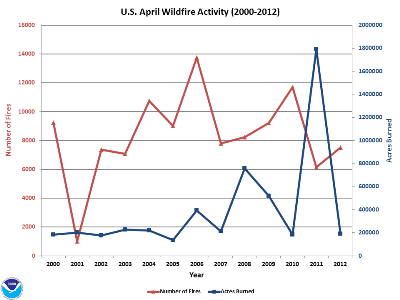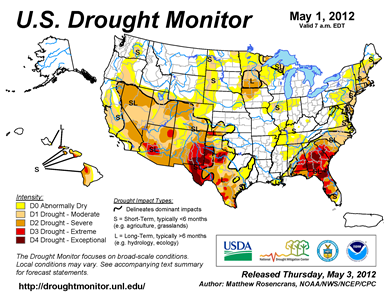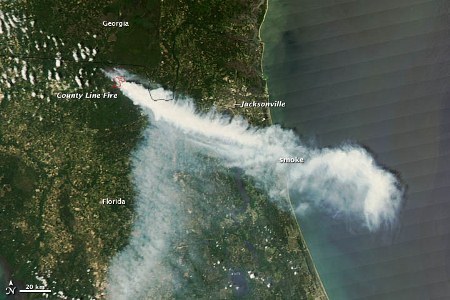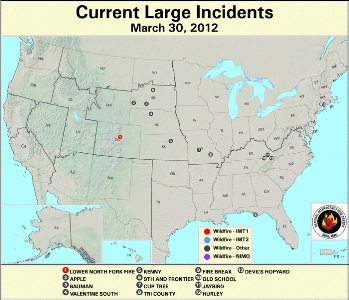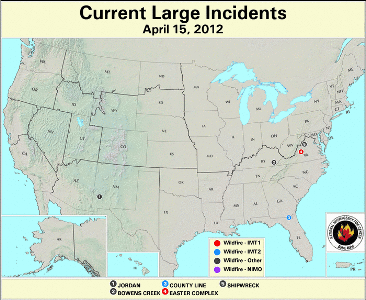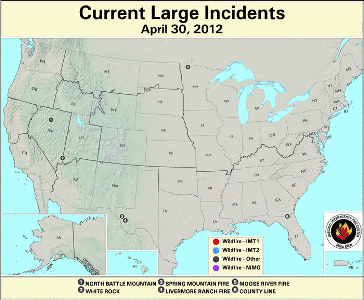Updated: 8 May 2012
Overview
During April, wildfire activity across the U.S. was below average, although warm and dry conditions occurred across a large portion of the country. The 191,062 acres which burned in April was the fifth least in the period of record, and the 7,506 fires was also the fifth least.
According to the National Interagency Fire Center (NIFC) :
For more wildfire statistics visit U.S. Wildfires.
Discussion
As a whole, the contiguous U.S. had its third warmest April on record, with warmer-than-average temperatures across the central regions of the country, as well as the Northeast. Precipitation totals were mixed during April, with wetter-than-average conditions across the West Coast, the Northern Rockies, and the Northern and Central Plains. Dry conditions were present across the Southeast, stretching northward into the Great Lakes. Please see the U.S. temperature and precipitation report for additional information. According to the U.S. Drought Monitor, the percent area of the contiguous U.S. experiencing Moderate-to-Exceptional Drought (D1-D4) grew from 36.8 percent at the beginning of April to 38.2 percent at the beginning of May. Drought conditions continued to deteriorate along the Eastern Seaboard, particularly in the Northeast and Southeast. Drought remained generally unchanged across the Southern Plains. The drought picture was mixed across the West. Above-average precipitation across parts of California improved drought conditions by one category there, while dry conditions across the interior West led to worsening drought.
Significant Events
The County Line fire, which burned in northern Florida during most of the month, was fully contained by the end of April. The fire was ignited on April 5th by a lightning strike, and very dry conditions across the region provided ample fuel for the flames. By the end of the month the fire had charred nearly 35,000 acres. The main impact from the fire was the smoke plume which led to poor air quality conditions in Jacksonville, Florida, the state’s most populous city.
Dry, windy, and warm conditions across the Northeast caused ideal wildfire conditions during the middle of April. Wildfires were reported across New England, New Jersey, and Long Island. The largest impact from the flames was the low air quality conditions across the densely populated region.
Monthly Wildfire Conditions
Wildfire information and environmental conditions are provided by the National Interagency Fire Center (NIFC) and the U.S. Forest Service (USFS) Wildland Fire Assessment System (WFAS).
At the beginning of April, there were 13 large wildfires burning across the country. Three large fires were burning across the Southern Appalachians of Virginia and Tennessee, where moderately low 10-hour fuel moistures were observed. Four large wildfires were active across South Dakota and Nebraska, where low 1,000-hour fuel moistures were observed. Three fires were burning in Kansas and Missouri which were experiencing low 10-hour fuel moistures at the end of the month. One fire was burning in the panhandle of Florida, where high KBDI values were present. The last fire burning was the Lower North Fork Fire in Colorado, where low 10-hour and 100-hour fuel moistures combined with very strong winds to create high fire danger.
On April 15th, there were five large wildfires burning nationwide. Three of the fires were burning in the central Appalachians of Virginia and Kentucky, where moderate fire danger and low 10-hour fuel moistures were observed. One large wildfire was active in New Mexico, where ongoing drought conditions led to increased fire danger, high KBDI values, and low fuel moistures. The County Line Fire in Florida was also burning, where very high KBDI values were observed.
At the end of April, there were six large wildfires active. The County Line Fire continued to burn in Florida. Two large wildfires were burning in west Texas, where ongoing drought conditions contributed to very high fire danger, high KBDI values and low 10-hour and 100-hour fuel moistures. Two fires were active in Nevada, where shorter term drought led to high KBDI values and fire danger, and extremely low 10-hour fuel moistures. One additional fire was active in Minnesota, where high fire danger was observed.
 NOAA's National Centers for Environmental Information
NOAA's National Centers for Environmental Information
